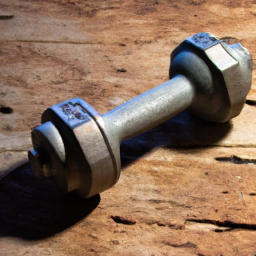You know the secret, don’t you? The secret to maximizing your fitness gains and taking your workouts to the next level? It lies in harnessing the power of compound movements. Yes, you heard it right. Compound movements, those exercises that engage multiple muscle groups simultaneously, are the key to achieving a more efficient and effective workout routine.
Designing a compound exercise workout routine may sound daunting at first, but fear not! With a little know-how and some guidance, you’ll be well on your way to reaping the benefits of these powerhouse exercises. A compound exercise routine not only saves you time by working multiple muscle groups in one go but also helps you build functional strength and improve coordination. Whether you’re a beginner or a seasoned gym-goer, incorporating compound movements like squats, deadlifts, and push-ups into your workout routine can yield impressive results.
So, why wait? Start integrating compound exercises into your workouts today and discover the amazing difference they can make. Get ready to challenge your body, increase strength, and unlock your full potential with the power of compound movements!
Benefits of Compound Movements
Compound movements, also known as multi-joint exercises, offer a wide range of benefits that can enhance your overall fitness and strength. These exercises engage multiple muscle groups and joints simultaneously, resulting in more muscle activation than isolated exercises. By incorporating compound movements into your workout routine, you can maximize your gains and achieve efficient results. Let’s explore some of the key benefits of compound movements in more detail.
Increased Muscle Activation
One of the primary advantages of compound movements is the increased muscle activation they provide. Since these exercises involve multiple muscle groups working together, they require more coordination and effort from your body. For example, the squat engages not only your quadriceps but also your hamstrings, glutes, and core muscles. This synergy of muscle activation helps to develop overall strength and stimulate muscle growth more effectively than isolated exercises.
Time Efficiency
If you are looking for an efficient way to optimize your workout sessions, compound movements are the answer. Since they engage multiple muscle groups at once, you can work out more muscles in less time compared to performing isolated exercises. For instance, performing a deadlift works your lower back, glutes, hamstrings, and even your upper body to some extent. By focusing on compound movements, you can make the most of your limited time and achieve greater overall muscular development.
Functional Strength
Compound movements mimic real-life movements, making them highly effective for building functional strength. Activities such as lifting heavy objects, climbing stairs, or pushing a heavy cart require the activation of multiple muscle groups simultaneously. By training your body with compound exercises, you are essentially preparing it for these everyday physical challenges. Developing functional strength through compound movements can significantly improve your daily life activities and enhance your athletic performance.
More Caloric Expenditure
Compound movements are known for their ability to burn a higher number of calories compared to isolated exercises. This is because compound movements engage multiple muscles, causing an increased metabolic demand on your body. The more muscles you activate during a workout, the more calories you burn. Additionally, compound movements stimulate your cardiovascular system, resulting in an elevated heart rate and increased calorie expenditure. By incorporating compound movements into your routine, you can effectively burn fat, enhance your metabolism, and support weight management goals.
Choosing the Right Compound Exercises
Now that we understand the benefits of compound movements, it’s crucial to choose the right exercises that align with your goals and target the major muscle groups effectively. When selecting compound exercises, consider the following factors to optimize your workout routine:
Identify Major Muscle Groups
Before diving into specific exercises, it’s important to identify the major muscle groups you want to target. This will ensure that your workout routine covers all the essential areas of your body. Common muscle groups targeted by compound movements include the chest, back, shoulders, legs, and core. Analyze your fitness goals and choose exercises that will effectively engage these major muscle groups.
Consider Movement Patterns
The movement patterns associated with compound exercises play a significant role in their effectiveness. Some common compound movement patterns include pushing, pulling, squatting, and lunging. Each of these movement patterns places varying levels of stress on different muscle groups. Understanding these movement patterns will allow you to choose exercises that align with your goals and ensure a well-rounded workout routine.
Account for Individual Goals
Everyone has different goals when it comes to fitness. Some individuals may aim to build strength and muscle mass, while others may prioritize weight loss or improving cardiovascular fitness. Consider your specific goals and select compound exercises that cater to those objectives. For example, if your goal is to build strength, exercises like the bench press, deadlift, and squat would be appropriate choices. On the other hand, if fat loss is your primary goal, incorporating high-intensity compound exercises such as burpees or kettlebell swings may be more suitable.
Progression and Variation
To continuously challenge your body and make progress, it’s essential to incorporate progression and variation into your compound exercise routine. Gradually increase the resistance, volume, or intensity of your workouts over time to promote muscle growth and strength development. Additionally, periodically introducing new exercises or variations can prevent plateaus and keep your workouts engaging and effective.

Creating Your Compound Exercise Workout Routine
Now that you have a better understanding of the benefits of compound movements and how to choose the right exercises, let’s explore how to construct an effective compound exercise workout routine. By following a structured plan, you can optimize your workouts and achieve your fitness goals more efficiently.
Warm-up and Mobility
Before diving into the main compound exercises, it’s crucial to warm up your body and improve mobility. Start with a dynamic warm-up routine that includes movements such as leg swings, arm circles, and hip rotations to increase blood flow, raise your core temperature, and prepare your muscles for the upcoming workout. Additionally, incorporating mobility exercises like foam rolling or stretching can help improve joint mobility and prevent injuries.
Exercises for Upper Body
Begin your compound exercise routine by targeting the major muscle groups in your upper body, including the chest, back, shoulders, and arms. Choose compound exercises such as the bench press, pull-ups, overhead press, and push-ups to effectively engage and strengthen these muscle groups. Aim to perform 2-4 sets of each exercise, with a moderate number of repetitions that challenge your muscles without compromising your form.
Exercises for Lower Body
Next, shift your focus to the major muscle groups in your lower body, including the quadriceps, hamstrings, glutes, and calves. Incorporate compound movements such as squats, lunges, deadlifts, and calf raises into your routine to stimulate muscle growth and enhance lower body strength. As with the upper body exercises, aim for 2-4 sets of each exercise, adjusting the weight and repetitions based on your individual fitness level.
Core and Stabilization Exercises
To complete your compound exercise workout routine, include exercises that target your core muscles and improve overall stability. Compound movements like planks, Russian twists, or mountain climbers engage not only your abdominal muscles but also the muscles of your lower back and hips. By incorporating these exercises, you can strengthen your core, improve posture, and enhance overall muscular balance.
Sample Compound Exercise Workout Routines
To provide you with a starting point for constructing your compound exercise workout routine, here are a few sample routines that you can customize based on your goals and preferences.
Full Body Compound Workout
This routine is ideal for individuals looking to work their entire body in one session. Perform compound exercises for each major muscle group, including both upper and lower body exercises. Aim for 2-3 sets of each exercise, with 8-12 repetitions per set.
Sample Full Body Compound Workout:
- Squats: 3 sets x 10 reps
- Bench Press: 3 sets x 10 reps
- Pull-Ups/Assisted Pull-Ups: 3 sets x 10 reps
- Overhead Press: 3 sets x 10 reps
- Deadlifts: 3 sets x 10 reps
- Planks: 3 sets x 30 seconds
Upper/Lower Split Routine
This routine is suitable for individuals who prefer to divide their training sessions into upper and lower body workouts. Alternate between upper and lower body compound exercises on different training days to allow for sufficient recovery. Aim for 3-4 sets of each exercise, with 6-8 repetitions per set.
Sample Upper/Lower Split Routine:
Upper Body Day:
- Bench Press: 4 sets x 8 reps
- Bent-Over Rows: 4 sets x 8 reps
- Shoulder Press: 4 sets x 8 reps
- Lat Pulldowns: 4 sets x 8 reps
Lower Body Day:
- Squats: 4 sets x 8 reps
- Romanian Deadlifts: 4 sets x 8 reps
- Lunges: 4 sets x 8 reps (each leg)
- Calf Raises: 4 sets x 12 reps
Push/Pull Compound Training
This routine focuses on push and pull movements, allowing for balanced upper body development. Perform compound exercises that involve pushing movements on one day and pulling movements on another day. Aim for 3-4 sets of each exercise, with 8-10 repetitions per set.
Sample Push/Pull Compound Training Routine:
Push Day:
- Bench Press: 4 sets x 8 reps
- Overhead Press: 4 sets x 8 reps
- Push-Ups: 4 sets x 10 reps
- Tricep Dips: 4 sets x 10 reps
Pull Day:
- Deadlifts: 4 sets x 8 reps
- Pull-Ups/Assisted Pull-Ups: 4 sets x 8 reps
- Bent-Over Rows: 4 sets x 10 reps
- Bicep Curls: 4 sets x 10 reps
Circuit Training with Compound Movements
Circuit training involves performing a series of compound exercises back-to-back, with minimal rest in between. This type of workout routine combines cardiovascular benefits with strength training. Choose 5-8 compound exercises, targeting various muscle groups, and perform each exercise for a set amount of time or repetitions before moving on to the next exercise. Complete the circuit for 2-3 rounds, resting for 1-2 minutes between rounds.
Sample Compound Circuit Training Routine:
- Medicine Ball Squat and Press: 45 seconds
- Romanian Deadlifts: 45 seconds
- Push-Ups: 45 seconds
- Bent-Over Rows: 45 seconds
- Mountain Climbers: 45 seconds
- Plank: 45 seconds
Modify the duration or intensity based on your fitness level, aiming to challenge yourself while maintaining proper form throughout the circuit.
Structuring Sets and Repetitions
When designing your compound exercise workout routine, it’s important to understand the concepts of sets, repetitions, and how they influence your training goals.
Defining Sets and Reps
A set refers to the number of times you perform a specific exercise, while repetitions (reps) refer to the number of times you repeat a specific movement within a set. For example, performing 3 sets of 10 repetitions means doing the exercise 10 times in each of the 3 sets.
Strength vs. Hypertrophy Training
The number of sets and repetitions you choose should align with your specific training goals. If your primary focus is strength development, you may opt for lower repetitions and higher weight. This could involve performing 3-6 sets of 1-6 repetitions, allowing for heavier loads and maximal strength gains.
On the other hand, if your goal is hypertrophy, which refers to muscle growth, you may increase the number of repetitions and decrease the weight slightly. Aim for 3-4 sets of 8-12 repetitions, using a weight that challenges your muscles and stimulates growth.
Progressive Overload Principles
To continue making progress over time, it’s important to incorporate progressive overload principles into your compound exercise routine. This involves gradually increasing the load, volume, or intensity of your workouts. For example, you can progressively increase the weight you lift, increase the number of repetitions, or reduce the rest periods between sets.
By gradually challenging your body, you provide the stimulus needed for muscle adaptation and growth. However, it’s crucial to progress gradually and pay attention to your body’s response to avoid injury and overtraining.
Rest Periods between Sets
Rest periods during compound exercises play a significant role in your overall workout performance and recovery. The duration of your rest periods can influence your training goals and the intensity of each set. For strength-focused workouts, longer rest periods (2-3 minutes) allow for better recovery between sets, enabling you to lift heavier loads. On the other hand, shorter rest periods (30-90 seconds) can increase the cardiovascular demand of your workout and promote muscle endurance and hypertrophy.
Adjust the rest periods based on your goals and preferences, ensuring adequate recovery for optimal performance.
Proper Form and Technique
Executing compound movements with proper form and technique is crucial to prevent injuries, maximize muscle activation, and ensure optimal results. Paying attention to the following factors will help you maintain the correct form throughout your workouts:
Maintaining Neutral Spine Alignment
Proper spinal alignment is essential during compound exercises to avoid excessive strain on your back and reduce the risk of injury. Engage your core muscles and maintain a neutral spine position throughout each movement. Avoid rounding or arching your back, as this places unnecessary stress on your vertebral column. Proper form ensures that the intended muscles are effectively targeted while minimizing the risk of strains or imbalances.
Controlling Range of Motion
Maintaining control over the range of motion is crucial in maximizing the effectiveness of compound exercises. Performing full range of motion allows for maximal activation of muscle fibers, enhancing strength gains and flexibility. However, avoid excessive range of motion that compromises your form or causes discomfort. Strive to move smoothly through the entire exercise, maintaining control over the weights and your body throughout the process.
Engaging Target Muscles
To reap the full benefits of compound movements, it’s important to focus on the targeted muscles during each exercise. Visualize the working muscles and concentrate on contracting and engaging them during the lifting and lowering phases. This mind-muscle connection enhances muscle activation and ensures that you’re getting the most out of each movement. Avoid relying solely on momentum or using other muscle groups to compensate for weaker areas.
Breathing and Tempo
Proper breathing techniques and tempo contribute to your overall performance and safety during compound movements. Breathe in before initiating the movement and exhale as you exert force. This helps stabilize your core and maintain proper intra-abdominal pressure. Additionally, controlling the tempo of each repetition ensures proper form and muscle activation. Avoid rapid or jerky movements, and focus on controlled lowering and lifting phases for maximal benefit.
Incorporating Compound Movements into Your Fitness Routine
Now that you have a solid understanding of compound movements and how to incorporate them into your workout routine, it’s essential to consider important factors to maximize their effectiveness and longevity.
Frequency and Progression
The frequency at which you incorporate compound movements into your fitness routine depends on your level of experience, goals, and overall recovery capacity. Beginner or intermediate individuals can start with 2-3 compound workouts per week, allowing for ample recovery between sessions. However, more advanced lifters may require additional training sessions to continue progressing.
As you start to build strength and establish a routine, focus on progressively increasing the resistance, volume, or intensity of your workouts. This can be achieved by adding more weight, increasing the number of sets or repetitions, or reducing the rest periods between sets. To prevent plateauing, regularly reassess your progress and make necessary adjustments to keep challenging your body.
Balancing with Isolation Exercises
While compound movements are highly effective for overall strength and muscle development, incorporating isolation exercises can help target specific muscle groups or address weak areas. Isolation exercises, such as bicep curls or tricep extensions, can be added to your compound exercise routine to provide additional stimulation to individual muscles. Aim for a balanced approach, giving equal attention to compound and isolation exercises to promote overall muscular balance and aesthetics.
Considering Recovery and Rest
Allowing sufficient recovery and rest between compound workouts is crucial for muscle repair and growth. Your body needs time to adapt to the stress placed upon it during intense training sessions. Adequate sleep, proper nutrition, and active recovery techniques, such as stretching or foam rolling, help support the recovery process.
Pay attention to any signs of excessive fatigue or overtraining and adjust your training frequency or intensity accordingly to prevent injury and optimize results. Remember, progress is made outside the gym during the recovery phase.
Listen to Your Body
One of the most important aspects of incorporating compound movements into your fitness routine is listening to your body. Everyone is unique, and what works for someone else may not work for you. Pay attention to how your body responds to different exercises and adjust accordingly.
If a particular movement causes discomfort or pain in your joints or muscles, consider modifying the exercise or consulting a fitness professional for guidance. Always prioritize safety and proper form over ego-driven weightlifting.
Common Mistakes to Avoid
To ensure a safe and effective compound exercise workout routine, it’s important to be aware of common mistakes that can hinder progress or lead to injuries. By avoiding these pitfalls, you can optimize your training and achieve better results.
Using Incorrect Weights
Using weights that are too heavy or too light can compromise your form and prevent you from reaping the benefits of compound movements. Select a weight that challenges you while allowing you to maintain proper form throughout the exercise. Gradually increase the weight as you build strength and mastery of the movement.
Neglecting Proper Warm-up
Skipping or rushing through your warm-up can increase the risk of injury and limit your performance during compound movements. Take the time to perform dynamic stretches, mobility exercises, and light cardio to prepare your body for the upcoming workout. Gradually ramp up the intensity of your warm-up, starting with lower weights and gradually increasing resistance.
Poor Exercise Selection
Choosing inappropriate compound exercises can lead to muscle imbalances or inadequate targeting of major muscle groups. Ensure that your exercise selection aligns with your goals and targets all the necessary muscle groups. Consulting a fitness professional or conducting thorough research can help you choose the most appropriate exercises for your needs.
Lack of Form and Technique
Performing compound movements with poor form and technique not only limits the effectiveness of the exercise but also increases the risk of injury. Prioritize learning and mastering proper form before adding more weight or intensity. Focus on executing each exercise with precision, maintaining control and stability throughout the movement.
Tracking and Measuring Progress
Tracking and measuring your progress are essential components of an effective compound exercise routine. By monitoring your performance, you can identify strengths, weaknesses, and areas for improvement. Here are a few strategies to help you track your progress effectively:
Establishing Baseline Measurements
Before starting your compound exercise routine, establish baseline measurements to track your progress. This can include measurements like body weight, body fat percentage, or specific strength assessments such as maximal lift capabilities. Regularly take these measurements to assess changes and ensure that you’re moving towards your desired goals.
Recording Training Volume
Training volume refers to the total amount of work performed during your workouts. Keep a record of the weight, sets, and repetitions performed for each compound exercise. By tracking your training volume, you can monitor progress and ensure that you’re consistently challenging yourself.
Periodic Testing and Assessments
Periodically testing your strength, endurance, or mobility can provide valuable insight into your progress and areas of improvement. For example, testing your one-repetition maximum (1RM) for specific compound exercises can help gauge your strength gains. Similarly, performing fitness assessments such as timed runs or bodyweight exercises allows you to measure improvements in cardiovascular fitness and muscular endurance.
Adjusting the Workout Routine
Based on your progress and goals, periodically reassess and adjust your compound exercise routine. Increase the intensity, volume, or variation of your workouts to continue challenging your body. This could involve adding more weight, incorporating new exercises, or modifying the number of sets and repetitions. Regularly adjusting your routine ensures that your body continues to adapt and progress over time.
Conclusion
Incorporating compound movements into your workout routine is a wise choice for optimizing your fitness and strength gains. By understanding the benefits of compound movements, choosing the right exercises, and structuring your workouts effectively, you can create a comprehensive compound exercise routine that suits your goals and preferences.
Remember to prioritize proper form and technique to maximize the benefits of each movement. Listen to your body, track your progress, and make adjustments as needed. Consistency and commitment to your compound exercise routine will ultimately lead to improved strength, muscle development, and overall fitness. So, embrace the power of compound movements and design a workout routine that sets you on the path to success!




